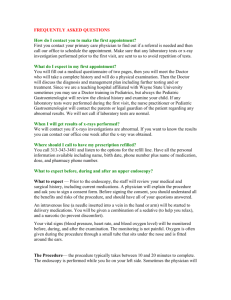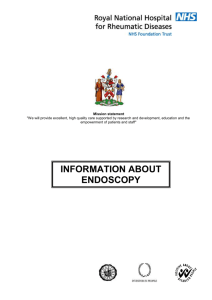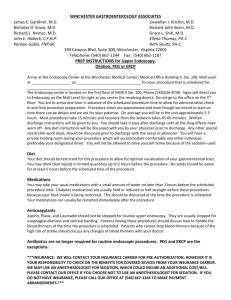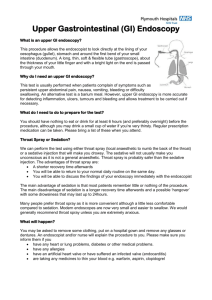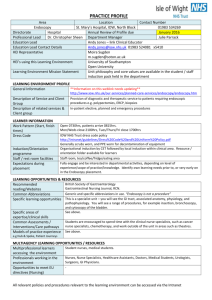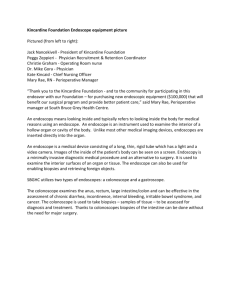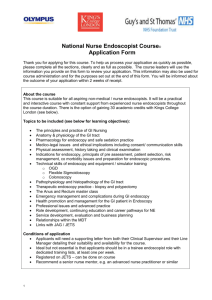Associates in Gastroenterology & Liver Disease, LLC
advertisement
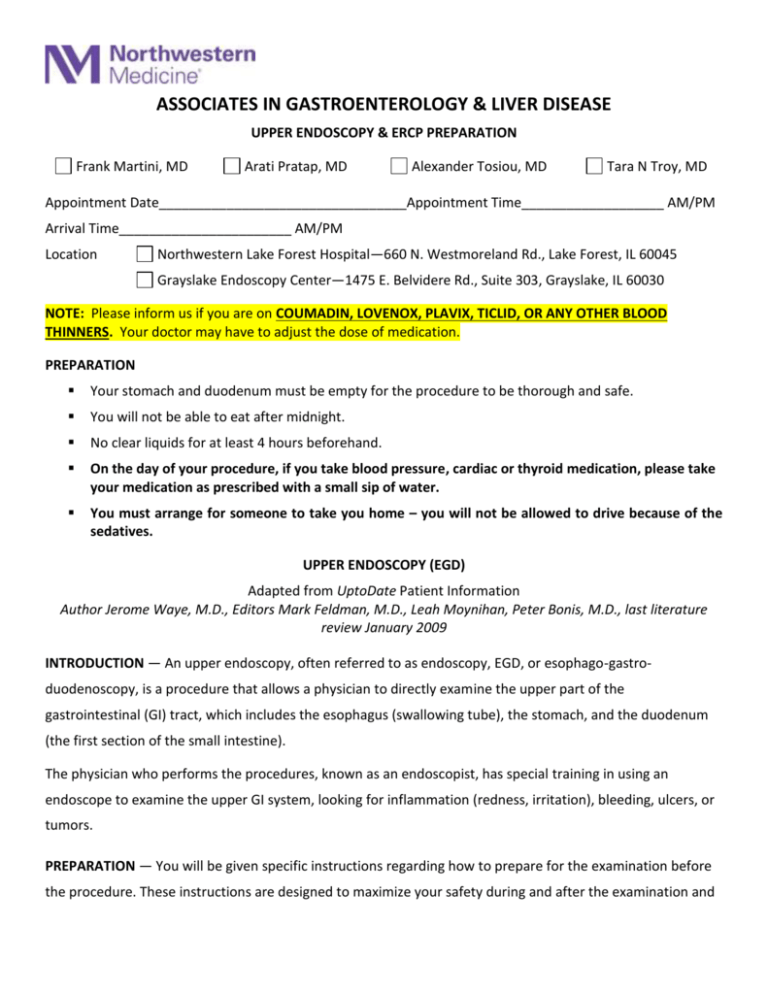
ASSOCIATES IN GASTROENTEROLOGY & LIVER DISEASE UPPER ENDOSCOPY & ERCP PREPARATION Frank Martini, MD Arati Pratap, MD Alexander Tosiou, MD Tara N Troy, MD Appointment Date_________________________________Appointment Time___________________ AM/PM Arrival Time_______________________ AM/PM Location Northwestern Lake Forest Hospital—660 N. Westmoreland Rd., Lake Forest, IL 60045 Grayslake Endoscopy Center—1475 E. Belvidere Rd., Suite 303, Grayslake, IL 60030 NOTE: Please inform us if you are on COUMADIN, LOVENOX, PLAVIX, TICLID, OR ANY OTHER BLOOD THINNERS. Your doctor may have to adjust the dose of medication. PREPARATION Your stomach and duodenum must be empty for the procedure to be thorough and safe. You will not be able to eat after midnight. No clear liquids for at least 4 hours beforehand. On the day of your procedure, if you take blood pressure, cardiac or thyroid medication, please take your medication as prescribed with a small sip of water. You must arrange for someone to take you home – you will not be allowed to drive because of the sedatives. UPPER ENDOSCOPY (EGD) Adapted from UptoDate Patient Information Author Jerome Waye, M.D., Editors Mark Feldman, M.D., Leah Moynihan, Peter Bonis, M.D., last literature review January 2009 INTRODUCTION — An upper endoscopy, often referred to as endoscopy, EGD, or esophago-gastroduodenoscopy, is a procedure that allows a physician to directly examine the upper part of the gastrointestinal (GI) tract, which includes the esophagus (swallowing tube), the stomach, and the duodenum (the first section of the small intestine). The physician who performs the procedures, known as an endoscopist, has special training in using an endoscope to examine the upper GI system, looking for inflammation (redness, irritation), bleeding, ulcers, or tumors. PREPARATION — You will be given specific instructions regarding how to prepare for the examination before the procedure. These instructions are designed to maximize your safety during and after the examination and to minimize possible complications. It is important to read the instructions ahead of time and follow them carefully. Do not hesitate to call the physician's office or the endoscopy unit if there are questions. You may be asked not to eat or drink anything for up to eight hours before the test. It is important for your stomach to be empty to allow the endoscopist to visualize the entire area and to decrease the possibility of food or fluid being vomited into the lungs while under sedation (called aspiration). You may be asked to adjust the dose of your medications or to stop specific medications (such as aspirin-like drugs) temporarily before the examination. You should discuss your medications with your physician before your appointment for the endoscopy. THE PROCEDURE — The procedure typically takes between 10 and 20 minutes to complete. The endoscopy is performed while you lie on your left side. A plastic mouth guard is placed between the teeth to prevent damage to the teeth and scope. The endoscope (also called a gastroscope) is a flexible tube that is about the size of a finger. The scope has a lens and a light source that allows the endoscopist to look into the scope to see the inner lining of the upper gastrointestinal tract, or to view it on a TV monitor. Most people have no difficulty swallowing the flexible gastroscope as a result of the sedating medications. Many people sleep during the test; others are very relaxed and generally not aware of the examination. The endoscopist may take tissue samples called biopsies (not painful), or perform specific treatments (such as dilation, removal of polyps, treatment of bleeding), depending upon what is found during the examination. Air is introduced through the scope to open the esophagus, stomach, and intestine, allowing the scope to be passed through these structures and improving the endoscopist's ability to see all of the structures. You may experience a mild discomfort as air is pushed into the intestinal tract. This is not harmful and belching may relieve the sensation. The endoscope does not interfere with breathing. Taking slow, deep breaths during the procedure may help you to relax. RECOVERY — After the endoscopy, you will be observed for 30-60 minutes while the sedative medication wears off. The medicines cause most people to temporarily feel tired or have difficulty concentrating and you should not drive or return to work after the procedure. The most common discomfort after the examination is a feeling of bloating as a result of the air introduced during the examination. This usually resolves quickly. Some patients also have a mild sore throat. Most patients are able to eat shortly after the examination. COMPLICATIONS — Upper endoscopy is a safe procedure and complications are uncommon. The following is a list of possible complications: Aspiration (inhaling) of food or fluids into the lungs, the risk of which can be minimized by not eating or drinking for the recommended period of time before the examination. The endoscope can cause a tear or hole in the tissue being examined. This is a serious complication but fortunately occurs only rarely. Bleeding can occur from biopsies or the removal of polyps, although it is usually minimal and stops quickly on its own or can be easily controlled. Reactions to the sedative medications are possible; the endoscopy team (doctors and nurses) will ask about previous medication allergies or reactions and about health problems such as heart, lung, kidney, or liver disease. Providing this information to the team ensures a safer examination. The medications may produce irritation in the vein at the site of the intravenous line. If redness, swelling, or discomfort occurs, you should call your endoscopist or primary care provider, or the number given by the nurse at discharge. AFTER UPPER ENDOSCOPY — Most patients tolerate endoscopy very well and feel fine afterwards. Some fatigue is common after the examination, and you should plan to take it easy and relax the rest of the day. The endoscopist can describe the result of their examination before you leave the endoscopy unit. If biopsies have been taken or polyps removed, you should call for results within one to two weeks. WHERE TO GET MORE INFORMATION — Your healthcare provider is the best source of information for questions and concerns related to your medical problem. Because no two patients are exactly alike and recommendations can vary from one person to another, it is important to seek guidance from a provider who is familiar with your individual situation. Use of UpToDate is subject to the Subscription and License Agreement Phone: 847.295.1300 ∙ Fax: 847.295.1574 1475 E. Belvidere Road Suite 301 Grayslake, Illinois 60030 900 N. Westmoreland Road Suite 225 Lake Forest, Illinois 60045
